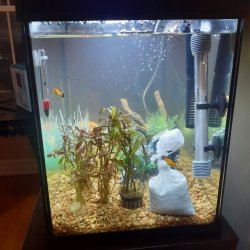Jean1984
New Member
Good Day,
I have high level of ammonia did two 25% water change in a row and still have high level of ammonia.I added 16 Tbsp of Marineland Zeolite Ammonia Removal in my fish tank in my media filter bag.
The bag is too big to go in my filter so i put it at the bottom of my tank.
How long should i leave the Zeolite in my fish tank?
I will monitor my ammonia level every 24hrs.
Thank you!
I have high level of ammonia did two 25% water change in a row and still have high level of ammonia.I added 16 Tbsp of Marineland Zeolite Ammonia Removal in my fish tank in my media filter bag.
The bag is too big to go in my filter so i put it at the bottom of my tank.
How long should i leave the Zeolite in my fish tank?
I will monitor my ammonia level every 24hrs.
Thank you!



